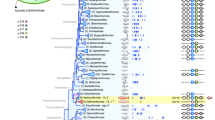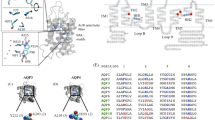Abstract
Aquaporin (AQP) water-channel proteins are freely permeated by water but not by ions or charged solutes1. Although mammalian aquaporins were believed to be located in plasma membranes, rat AQP6 is restricted to intracellular vesicles in renal epithelia2. Here we show that AQP6 is functionally distinct from other known aquaporins. When expressed in Xenopus laevis oocytes, AQP6 exhibits low basal water permeability; however, when treated with the known water channel inhibitor, Hg2+, the water permeability of AQP6 oocytes rapidly rises up to tenfold and is accompanied by ion conductance. AQP6 colocalizes with H+-ATPase in intracellular vesicles of acid-secreting α-intercalated cells in renal collecting duct. At pH less than 5.5, anion conductance is rapidly and reversibly activated in AQP6 oocytes. Site-directed mutation of lysine to glutamate at position 72 in the cytoplasmic mouth of the pore changes the cation/anion selectivity, but leaves low pH activation intact. Our results demonstrate unusual biophysical properties of an aquaporin, and indicate that anion-channel function may now be explored in a protein with known structure.
This is a preview of subscription content, access via your institution
Access options
Subscribe to this journal
Receive 51 print issues and online access
$199.00 per year
only $3.90 per issue
Buy this article
- Purchase on Springer Link
- Instant access to full article PDF
Prices may be subject to local taxes which are calculated during checkout





Similar content being viewed by others
References
Agre,P., Bonhivers,M. & Borgnia,M. J. The aquaporins, blueprints for cellular plumbing systems. J. Biol. Chem. 273, 14659–14662 (1998).
Yasui,M., Kwon,T.-H., Knepper,M. A., Nielsen,S. & Agre,P. Aquaporin-6: an intracellular vesicle water channel protein in renal epithelia. Proc. Natl Acad. Sci. USA 96, 5808–5813 (1999).
Ma,T., Frigeri,A., Skach,W. & Verkman,A. S. Cloning of a novel rat kidney cDNA homologous to CHIP28 and WCH-CD water channels. Biochem. Biophys. Res. Commun. 197, 654–659 (1993).
Fushimi,K. et al. Cloning and expression of apical membrane water channel of rat kidney collecting tubule. Nature 361, 549–552 (1993).
Gorin,M. B., Yancey,S. B., Cline,J., Revel,J. P. & Horwitz,J. The major intrinsic protein (MIP) on the bovine lens fiber membrane. Cell 39, 49–59 (1984).
Nielsen,S. et al. Vasopressin increases water permeability of kidney collecting duct by inducing translocation of aquaporin-CD water channels to plasma membrane. Proc. Natl Acad. Sci. USA 92, 1013–1017 (1995).
Mulders,S. M. et al. Water channel properties of major intrinsic protein of lens. J. Biol. Chem. 270, 9010–9016 (1995).
Ma,T., Yang,B., Kuo,W. L. & Verkman,A. S. cDNA cloning and gene structure of a novel water channel expressed exclusively in human kidney: evidence for a gene cluster of aquaporins at chromosome locus 12q13. Genomics 35, 543–550 (1996).
Preston,G. M., Carroll,T. P., Guggino,W. B. & Agre,P. Appearance of water channels in Xenopus oocytes expressing red cell CHIP28 protein. Science 256, 385–387 (1992).
Fahlke,C., Yu,H. T., Beck,C. L., Rhodes,T. H. & George,A. L. Jr Pore-forming segments in voltage-gated chloride channels. Nature 390, 529–532 (1997).
Roos,N., Benz,R. & Brdiczka,D. Identification and characterization of the pore-forming protein in the outer membrane of rat liver mitochondria. Biochem. Biophys. Acta 686, 204–214 (1982).
Friedrich,T., Breiderhoff,T. & Jentsch,T. J. Mutational analysis demonstrates that CIC-4 and CIC-5 directly mediate plasma membrane currents. J. Biol. Chem. 274, 896–902 (1999).
Blachly-Dyson,E. et al. Selectivity changes in site-directed mutants of the VDAC ion channel: structural implications. Science 247, 1233–1236 (1990).
Jung,J. S., Preston,G. M., Smith,B. L., Guggino,W. B. & Agre,P. Molecular structure of the water channel through aquaporin CHIP. The hourglass model. J. Biol. Chem. 269, 14648–14654 (1994).
Walz,T. et al. The three-dimensional structure of aquaporin-1. Nature 387, 624–627 (1997).
Mitsuoka,K. et al. Short α-helices in hourglass pore-forming domains of aquaporin-1, a water channel protein, visualized at 4.5 Å resolution. J. struct. Biol. (in the press).
Schwartz,G. J. & Al-Awqati,Q. Regulation of transepithelial H+ transport by exocytosis and endocytosis. Annu. Rev. Physiol. 48, 153–161 (1986).
Glickman,J., Croen,K., Kelly,S. & Al-Awqati,Q. Golgi membranes contain an electrogenic H+ pump in parallel to a chloride conductance. J. Cell Biol. 97, 1303–1308 (1983).
Günther,W., Luchow,A., Cluzeaud,F., Vandewalle,A. & Jentsch,T. J. CIC-5, the chloride channel mutated in Dent's disease, colocalizes with the proton pump in endocytotically active kidney cells. Proc. Natl Acad. Sci. USA 95, 8075–8080 (1998).
Jena,B. P. et al. Gi regulation of secretory visicle swelling examined by atomic force microscopy. Proc. Natl Acad. Sci. USA 94, 13317–13322 (1997).
Hirsch,S. et al. Isolation and sequence of a cDNA clone encoding the 31-kDa subunit of bovine kidney vacuolar H+-ATPase. Proc. Natl Acad. Sci. USA 85, 3004–3008 (1988).
Yool,A. J., Stamer,W. D. & Regan,J. W. Forskolin stimulation of water and cation permeability in aquaporin-1 water channels. Science 273, 1216–1218 (1996).
Agre,P. et al. Aquaporins and ion conductance. Science 275, 1490–1492 (1997).
Acknowledgements
We thank M. Lu for the AQP6 plasmid, M. A. Knepper for the anti-H+-ATPase, and M. R. T. Hall for confocal microscopy. Support was provided by grants from the NIH and the Cystic Fibrosis Foundation (P.A. and W.B.G.), the Human Frontier Science Program (M.Y.), and the Novo Nordic Foundation, the Karen Elise Jensen Foundation, the Danish Medical Research Council, the Biomembrane Research Center at Unviersity of Aarhus and the EU Commission (EU-Biotech and TMR Programmes) (S.N.).
Author information
Authors and Affiliations
Corresponding author
Rights and permissions
About this article
Cite this article
Yasui, M., Hazama, A., Kwon, TH. et al. Rapid gating and anion permeability of an intracellular aquaporin. Nature 402, 184–187 (1999). https://doi.org/10.1038/46045
Received:
Accepted:
Issue Date:
DOI: https://doi.org/10.1038/46045
This article is cited by
-
Aquaporin water channels: roles beyond renal water handling
Nature Reviews Nephrology (2023)
-
Aquaporins Display a Diversity in their Substrates
The Journal of Membrane Biology (2023)
-
Cooperativity in regulation of membrane protein function: phenomenological analysis of the effects of pH and phospholipids
Biophysical Reviews (2023)
-
Aquaporin ion conductance properties defined by membrane environment, protein structure, and cell physiology
Biophysical Reviews (2022)
-
A region within the third extracellular loop of rat Aquaporin 6 precludes trafficking to plasma membrane in a heterologous cell line
Scientific Reports (2021)
Comments
By submitting a comment you agree to abide by our Terms and Community Guidelines. If you find something abusive or that does not comply with our terms or guidelines please flag it as inappropriate.



